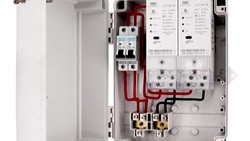Voltage fluctuations and flicker are terms that are often used interchangeably, but they refer to different phenomena in power systems. In this article, we will discuss the differences between voltage fluctuation and flicker, their causes, effects, and potential mitigation strategies. You can find a simplified description in the article Voltage Fluctuation and Flicker.
Voltage is an essential parameter in electrical power systems that must be maintained within specified limits to ensure the proper functioning of equipment and appliances. Variations in voltage can cause various issues, including decreased performance, damage to equipment, and an unstable power supply. Voltage fluctuations and flicker are two such phenomena that can lead to these problems.
Voltage Fluctuation
Voltage fluctuation refers to the variation in the voltage magnitude in a power system, which occurs due to changes in load, generation, or network configuration. It can be categorized as short-term or long-term fluctuations, depending on the duration of the changes.
Causes of Voltage Fluctuation
There are multiple causes for voltage fluctuation in electrical systems. Some common factors include:
- Load Variation
Fluctuations can occur when there are rapid changes in the electrical load within a system. Examples of load variation can include starting or stopping large motors or equipment, as well as the use of fluctuating power-hungry devices. - Grid Instability
Inadequate power supply and an unstable electrical grid can lead to voltage fluctuations. This can happen due to insufficient generation capacity, grid congestion, or a high demand for power exceeding the available supply. - Faults and Short Circuits
Electrical faults, such as short circuits or equipment malfunction, can cause sudden voltage fluctuations. These faults can lead to rapid changes in the electrical system's impedance or the flow of current, affecting voltage stability. - Reactive Power Imbalance
Reactive power, which is required for the operation of certain electrical devices, can cause voltage fluctuations. Imbalances between the capacitive and inductive loads within a system can lead to variations in voltage levels. - Voltage Regulation Issues
Poor voltage regulation by electrical utilities or incorrect transformer tap settings can result in voltage fluctuations. Inadequate control mechanisms and improper voltage level adjustment can contribute to voltage variation. - Weather and Environmental Factors
Extreme weather conditions, lightning strikes, and resulting voltage fluctuations in the grid can also impact the stability of the voltage supplied to electrical systems.
Effects of Voltage Fluctuation
Voltage fluctuation can have various effects depending on the magnitude and duration of the fluctuations. Here are some potential effects:
- Equipment Malfunction
Voltage fluctuations can cause equipment to malfunction or operate sub-optimally. Sensitive electronic devices, such as computers, may crash or experience data loss. Electrical motors may overheat or suffer damage. - Reduced Lifespan
Fluctuations in voltage can reduce the lifespan of electrical equipment. Components may wear out faster, leading to more frequent repairs or replacements. - Dimming or Flickering Lights
Voltage fluctuations can cause lights to dim or flicker, affecting visibility and potentially causing discomfort or eye strain. - Inefficient Power Consumption
Some devices, especially those with variable speed drives or power supplies, may consume more energy during voltage fluctuations, leading to higher electricity bills. - Data Loss or Corruption
Unstable voltage levels can result in data loss or corruption in digital systems, such as servers or storage devices. - Electrical Fires
Severe voltage fluctuations or surges can cause overheating or sparks, increasing the risk of electrical fires. - Interference or Noise
Voltage fluctuations may introduce electrical noise or interference that can disrupt the operation of sensitive electronic equipment, such as audio or video systems.
Mitigation of Voltage Fluctuation
The implementation of voltage regulators in the grid plays a crucial role in maintaining a consistent voltage level, mitigating fluctuations that may arise due to load changes or system disturbances. Surge protectors are instrumental in diverting excessive voltage transients, safeguarding equipment from sudden spikes that could otherwise lead to damage or malfunction.
Uninterruptible power supplies (UPS) offer additional protection by providing backup power during power outages or brownouts, ensuring a continuous supply of electricity to critical equipment. Regular maintenance of electrical infrastructure is also crucial to identify and repair any faults or deficiencies that may contribute to voltage fluctuations.
Furthermore, the establishment of a robust electrical infrastructure, including adequate wiring and grounding systems, can significantly minimize the occurrence of voltage fluctuations. The utilization of power conditioners further enhances stability by filtering out harmonic distortions and maintaining optimal voltage levels.

(symbol photo, credit Kingsley)
Flicker
Flicker is a phenomenon that describes the perceived fluctuation in the brightness of lights due to rapid voltage changes. It is defined by the flicker index.
The flicker index is typically calculated by analysing the fluctuations in the light output over a specific time period and comparing it to a reference level. A lower flicker index indicates a more stable and consistent light output, providing a more comfortable and pleasant visual experience.
Causes of Flicker
There are several potential causes of flicker in lighting systems. One common cause is the usage of incandescent or fluorescent lights powered by alternating current (AC) electrical systems, where variations in the voltage and current can lead to flickering. Older or malfunctioning ballasts in fluorescent lights can also contribute to flicker. Additionally, rapid switching of electrical loads, such as motors or large appliances, can cause voltage fluctuations and subsequent flickering.
Effects of Flicker
The effects of flicker can vary depending on the severity and duration of the fluctuations. Here are some common effects of flicker:
- Visual discomfort
Flickering lights can cause eye strain, headaches, and visual discomfort, particularly in sensitive individuals. - Reduced visibility
Rapid changes in light intensity can reduce visibility, making it harder to perform tasks that require precise visual perception. - Impaired concentration and productivity
Flickering lights can be distracting and disrupt concentration, leading to reduced productivity, especially in work environments. - Strobe effects
In some cases, flickering lights can create a stroboscopic effect, where moving objects appear to freeze or move in slow motion. This can be hazardous in situations where rapid movement needs to be accurately perceived. - Health effects
Prolonged exposure to flickering lights may cause health issues such as migraines, dizziness, fatigue, and even seizures in individuals with photosensitive epilepsy. - Equipment malfunction
Flicker can also affect electronic equipment, especially sensitive devices like computers, monitors, and cameras. It may result in screen flickering, image distortion, data corruption, or even equipment failure over time.
Mitigation of Flicker
To mitigate the effects of flicker, several methods can be employed, including:
- Flicker compensators
These devices monitor the voltage and inject reactive power into the system to counteract the effects of flicker-causing loads. - Soft starters
Installing soft starters on large motors can help reduce the rapid load changes that cause flicker. - Energy storage systems
Energy storage systems, such as batteries or flywheels, can be used to smooth out rapid power fluctuations and reduce flicker.
Flicker with Wind Turbines
In the context of wind turbines, flicker refers to the intermittent shadowing effect caused by the rotating blades as they pass between the sun and a nearby observer. This can result in a perceived fluctuation in the brightness of sunlight, which may cause visual discomfort for people living in proximity to wind farms.
Flickering caused by wind turbines is distinct from the flickering related to lighting systems and is not measured using the flicker index. Instead, specific guidelines and regulations are in place to limit the amount and duration of flicker caused by wind turbines in order to minimize any potential negative effects on nearby residents.
Voltage Fluctuation vs Flicker
While voltage fluctuation and flicker are related, they are distinct phenomena with different causes and effects:
- Voltage fluctuation refers to the variation in voltage magnitude in a power system, whereas flicker describes the perceived fluctuation in the brightness of lights due to rapid voltage changes.
- Voltage fluctuations can occur due to load changes, generation changes, or network configuration changes, while flicker is typically caused by rapid load changes, arc furnaces, or wind turbines.
- Voltage fluctuations can cause equipment malfunction, decreased efficiency, and premature failure, while flicker can lead to visual discomfort, reduced productivity, and interference with electronic equipment.
- Mitigation strategies for voltage fluctuations include automatic voltage regulators, transformer tap changing, and power factor correction, while flicker can be mitigated using flicker compensators, soft starters, and energy storage systems.
Takeaway
Voltage fluctuation and flicker are important considerations in power system design and operation, as they can have significant impacts on the performance and reliability of electrical equipment and the comfort of individuals in the affected area. Understanding the differences between these phenomena and their respective causes, effects, and mitigation strategies is essential for maintaining a stable and reliable power supply. By implementing appropriate mitigation measures, utilities and end-users can ensure that their electrical systems operate efficiently and safely, minimizing disruptions and prolonging equipment life.
Editor's note: This article was originally published in July 2023 and has been updated for comprehensiveness.





All comments are moderated before being published. Inappropriate or off-topic comments may not be approved.